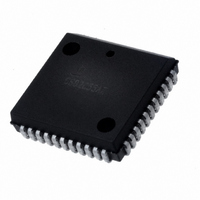CMS82C55AZ Intersil, CMS82C55AZ Datasheet - Page 5

CMS82C55AZ
Manufacturer Part Number
CMS82C55AZ
Description
IC I/O EXPANDER 24B 44PLCC
Manufacturer
Intersil
Datasheet
1.CMS82C55AZ.pdf
(26 pages)
Specifications of CMS82C55AZ
Interface
Programmable
Number Of I /o
24
Interrupt Output
No
Voltage - Supply
4.5 V ~ 5.5 V
Operating Temperature
0°C ~ 70°C
Mounting Type
Surface Mount
Package / Case
44-PLCC
Lead Free Status / RoHS Status
Lead free / RoHS Compliant
Frequency - Clock
-
Available stocks
Company
Part Number
Manufacturer
Quantity
Price
Company:
Part Number:
CMS82C55AZ
Manufacturer:
Intersil
Quantity:
316
Company:
Part Number:
CMS82C55AZ
Manufacturer:
TOSHIBA
Quantity:
150 562
Part Number:
CMS82C55AZ
Manufacturer:
INTERSIL
Quantity:
20 000
Company:
Part Number:
CMS82C55AZ96
Manufacturer:
Intersil
Quantity:
500
Operational Description
Mode Selection
There are three basic modes of operation than can be
selected by the system software:
When the reset input goes “high”, all ports will be set to the
input mode. After the reset is removed, the 82C55A can
remain in the input mode with no additional initialization
required. The control word register will contain 9Bh. During
the execution of the system program, any of the other modes
may be selected using a single output instruction. This
allows a single 82C55A to service a variety of peripheral
devices with a simple software maintenance routine. Any
port programmed as an output port is initialized to all zeros
when the control word is written.
FIGURE 3. BASIC MODE DEFINITIONS AND BUS INTERFACE
MODE 0
MODE 1
MODE 2
Mode 0 - Basic Input/Output
Mode 1 - Strobed Input/Output
Mode 2 - Bidirectional Bus
PB7-PB0
PB7-PB0
PB7-PB0
RD, WR
B
8
B
8
B
8
I/O
I/O
I/O
PC3-PC0
CONTROL
OR I/O
ADDRESS BUS
CONTROL BUS
4
DATA BUS
82C55A
D7-D0
CONTROL
I/O
C
C
C
5
CONTROL
PC7-PC4
OR I/O
4
I/O
MS82C55A, MQ82C55A, MP82C55A
PA7-PA0
PA7-PA0
PA7-PA0
A0-A1
CS
A
8
A
8
A
I/O
I/O
BI-
DIRECTIONAL
The modes for Port A and Port B can be separately defined,
while Port C is divided into two portions as required by the
Port A and Port B definitions. All of the output registers,
including the status flip-flops, will be reset whenever the
mode is changed. Modes may be combined so that their
functional definition can be “tailored” to almost any I/O
structure. For instance: Group B can be programmed in
Mode 0 to monitor simple switch closings or display
computational results, Group A could be programmed in
Mode 1 to monitor a keyboard or tape reader on an interrupt-
driven basis.
The mode definitions and possible mode combinations may
seem confusing at first, but after a cursory review of the
complete device operation a simple, logical I/O approach will
surface. The design of the 82C55A has taken into account
things such as efficient PC board layout, control signal definition
vs. PC layout and complete functional flexibility to support
almost any peripheral device with no external logic. Such
design represents the maximum use of the available pins.
Single Bit Set/Reset Feature (Figure 5)
Any of the eight bits of Port C can be Set or Reset using a
single Output instruction. This feature reduces software
requirements in control-based applications.
When Port C is being used as status/control for Port A or B,
these bits can be set or reset by using the Bit Set/Reset
operation just as if they were output ports.
D7 D6 D5 D4 D3 D2 D1 D0
CONTROL WORD
FIGURE 4. MODE DEFINITION FORMAT
PORT C (LOWER)
1 = INPUT
0 = OUTPUT
PORT B
1 = INPUT
0 = OUTPUT
MODE SELECTION
0 = MODE 0
1 = MODE 1
PORT C (UPPER)
1 = INPUT
0 = OUTPUT
PORT A
1 = INPUT
0 = OUTPUT
MODE SELECTION
00 = MODE 0
01 = MODE 1
1X = MODE 2
MODE SET FLAG
1 = ACTIVE
GROUP B
GROUP A
June 15, 2006
FN6140.2













